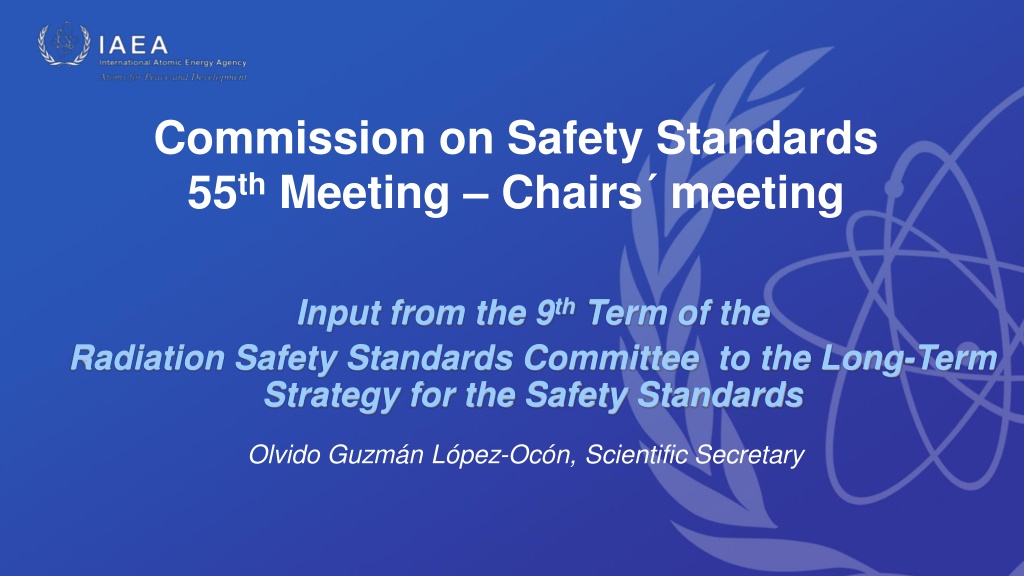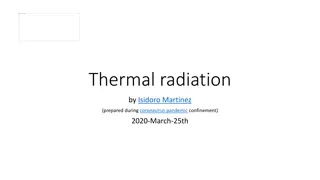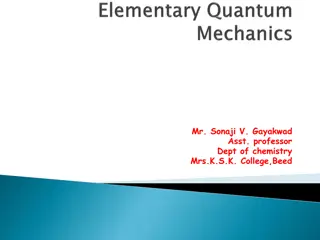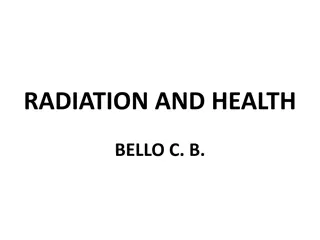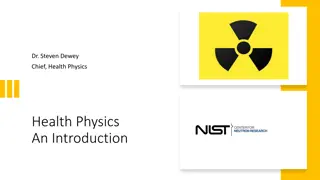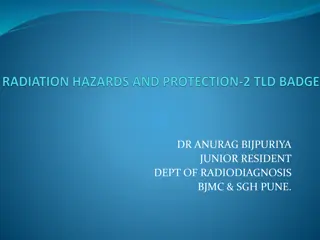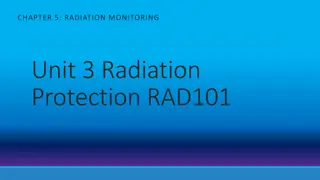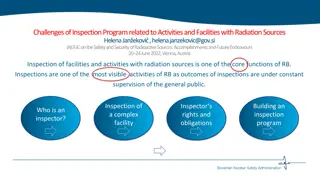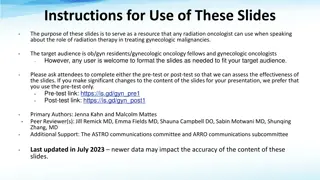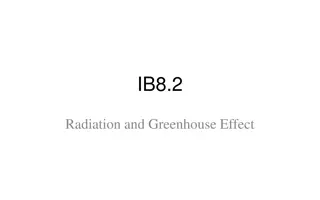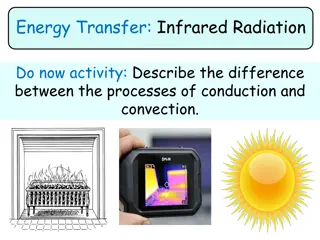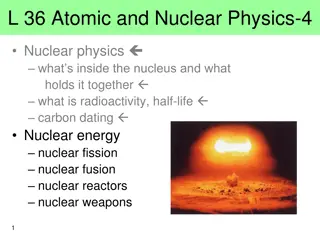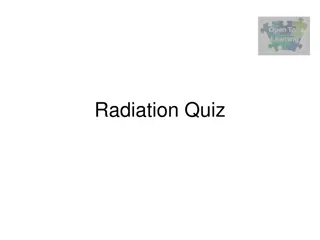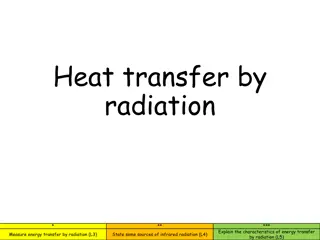Long-Term Strategy for Safety Standards in Radiation
Inputs from the 9th Term Radiation Safety Committee for the Long-Term Strategy are discussed, including the formation of an e-WG, the questionnaire development, and areas of focus such as environmental impacts, safety assessment, communication, and regulatory effectiveness. The document outlines the scope, work methods, membership details, and discussions on safety fundamentals. It emphasizes factors for future safety standards including AI, pandemics, climate change, and stakeholder engagement.
Download Presentation

Please find below an Image/Link to download the presentation.
The content on the website is provided AS IS for your information and personal use only. It may not be sold, licensed, or shared on other websites without obtaining consent from the author. Download presentation by click this link. If you encounter any issues during the download, it is possible that the publisher has removed the file from their server.
E N D
Presentation Transcript
Commission on Safety Standards 55thMeeting Chairs meeting Input from the 9th Term of the Radiation Safety Standards Committee to the Long-Term Strategy for the Safety Standards Olvido Guzm n L pez-Oc n, Scientific Secretary
Dedicated RASSC e-WG RASSC-52 (6 June 2022 ) - Item R.3 Brainstorming session on the long-term strategy for the Safety Standards Two documents were available on the Draft Standards for Comment Web Folder (iaea.org): R3.4 RASSC noted with appreciation RASSC s Chair initiative to establish an e-WG to provide RASSC inputs for the CSS work on the long-term plan for the IAEA safety standards. CSS concept paper for the long term strategy for the Safety Standards (All Safety Standards Committees) - For consideration and complement on the questionnaire [Draft 5, 1 April 2022] R3.5 RASSC held a preliminary discussion based on selected questions as provided in RASSC-52 Message #7 to inform the CSS on the long-term strategy for the Safety Standards R3.7 RASSC agreed to establish an e-WG on RASSC inputs for the CSS work on the long-term plan for the IAEA safety standards. The e- WG will be chaired by Mr Gareth Thomas from the United Kingdom. CSS draft medium term plan for the Safety Standards (All Safety Standards Committees) - For additional input and update mid 2022 [Draft, April 2022 updated more recently] R3.7 RASSC agreed to give a deadline until 30 of June to inform the Secretariat on nominations to the e-WG as well as to confirm names for those Member States which expressed willingness to participate in the e-WG. R3.7 The e-WG will present the summary of the work for the next RASSC meeting. The first e-WG meeting was planned to take place during the summer 2
Scope and Work methods Scope: RASSC focused (occupational, public, patient and the environment in ALL exposure situations) bearing in mind the remit of the other committees. Membership: 16 Nominated representatives from 12 Member States and 1 international organisation. Chair from UK Three meetings: 13 September, 6 October and 11 November 2022 Questionnaire developed around six topics with responses from 11MS + WNA analysed and discussed by the eWG: 1. Environmental scan of factors with potential to impact Safety Standards in the long-term Environmental changes; Consideration of potential unplanned disruptors (including pandemics); Technological changes (including artificial intelligence); Risk management approaches 2. Safety Assessment 3. Providing for the application of the Safety Standards 4. Communication, Stakeholder Involvement, Openness, Transparency and Accountability? 5. Effectiveness of the Regulatory Body 6. Higher level questions on the Structure and Framework of the Safety Standards Safety Fundamentals-SF-1, General Safety Requirements, Specific Safety Requirements, Safety guides Draft document reviewed and discussed by RASSC in session during RASSC-53 (Nov. 2022). Final version agreed during RASSC-53 after introducing some modifications as proposed by RASSC Members. Final version sent to the CSS for its consideration. 3
RASSC inputs to Long-Term Strategy for SS Document approved during RASSC-53 representing the opinion of the committee on aspects to be considered in the Preparation of the long-term strategy for the Safety Standards 37 Paragraphs structured in 11 sections: Are the current structure and framework of the IAEA safety standards fit for purpose? Factors to be considered in future Standards Covid-19 implications and foreseeing other pandemics Climate change impacts New and emerging technologies Artificial Intelligence (AI), deep learning, big data Towards an all-hazards approach Protection of the environment Communication, stakeholder involvement, openness, transparency and accountability Providing for the application of the Safety Standards Improving the efficiency of the Regulatory Body Page 1 of 12 Link to RASSC inputs for the Preparation of the Long-term strategy for the IAEA 4
RASSC inputs to Long-Term Strategy for SS EXEMPLE 9. RASSC has identified a range of new/ changing factors which should be considered in the long- term strategy of the Safety Standards and agrees that the Agency should broaden the scope of Covid- 19 pandemic considerations to considering other pandemics, wider potential unplanned disruptors , international crises and the need for resilience and business continuity. RASSC s scan of potentially significant unplanned disruptors include: Pandemics, which amongst other impacts may also reduce the availability of competent personnel. International crises which might involve financial crisis, energy crisis, electricity supply, national and international travel restrictions . Belligerent actions, including potential military impacts on facilities and terrorist acts, which may damage the integrity of safety systems. Cyber security where its effects may impact the person or organization responsible for facilities and activities that give rise to radiation risks and regulators and have consequences for occupational, public and medical exposures. Integrity requirements for dosimetry systems and software needed for radiological protection purposes. Emerging new technologies which might have impact on implementation of safety standards. Climate change, including extreme weather events and/or conditions, among them periods of extended or extreme high (summer) or low (winter) temperatures, drought, severe storms, floods, rising sea levels, sea/river/lake water temperatures, rising and falling river levels, permafrost thawing, coastal, pluvial and fluvial flooding and erosion. Artificial Intelligence (AI) and deep learning. Financial stability (bankruptcy, temporary cash-flow problems) affecting operators and supply chains. Combined hazards/ all hazards approach. Loss of public acceptance in various technologies/ practices. Shortage and/or availability of competent/ trained personnel at authorities and the person or organization responsible for facilities and activities that give rise to radiation risks. 5
RASSC inputs to Long-Term Strategy for SS EXEMPLE Protection of the environment 24. RASSC considers that in the context of current environmental trends the current standards are generally fit for purpose in protecting the environment and acknowledges that there are still some challenges in the implementation, such as NORM waste management challenges due to its wide scope and large quantities of materials involved. However, acknowledging that the current Safety Standards do not specifically reference current environmental trends, as well as, protecting the environment (specifically GSR Part 3 does not have a requirement to protect the environment in-conjunction with the protection of people and workers), it is important to include environmental changes and take this into account when reviewing high-level Standards or developing new Standards. Furthermore, protection of environment should be better explained to public. 6
RASSC inputs to Long-Term Strategy for SS EXEMPLE Providing for the application of the Safety Standards 33. RASSC considers that the Agency should envisage strategies and approaches to enhance the collection of views of those Member States who are the main users of the Safety Standards but not frequently represented in RASSC or other IAEA Committees. RASSC suggest the following being explored: improving communication channels by opening access platforms like webinars and workshops, holding more virtual/hybrid meetings and local/ regional meetings, conducting seminars and surveys through official channels, utilizing national contacts made during various IAEA missions and regional workshops, and considering contacting the permanent mission of all countries to enhance their awareness. . 7
RASSC inputs to Long-Term Strategy for SS FOOTNOTES The Russian Federation objected to the inclusion of the statements "should consider hazards, including those as consequence of social unrest and lost political stability" and international crises which might involve financial crisis, energy crisis, electricity supply, travel restrictions in paragraph 9 and of statement belligerent actions including potential military impacts on facilities and terrorist acts which may damage the integrity of safety systems on paragraph 23, on the basis that it is outside the scope of the IAEA mandate and Terms of Reference of the Safety Standards. At the RASSC 53 meeting the IAEA Secretariat clarified that following initial consultation with the IAEA Office of Legal Affaires there appear to be no legal obstacle to providing technical guidance on nuclear safety and security during armed conflict. Consultation within the Secretariat is still ongoing. It was emphasised that safety standards are and will continue to be consensus documents of Member States. It was also noted at RASSC 53 that this document is not a safety standard but is only input into developing the long-term strategy for the development of the safety standards as requested by the CSS. 8
